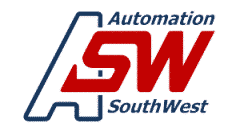
In today’s world of machine safety, some equipment applications require higher levels of experience, knowledge, and expertise to ensure the safety of both machine operators and maintenance personnel. All too often, machine safety issues arise when local maintenance personnel are asked to engineer and validate the safety of complex plant floor equipment.
Automation Southwest can do much more than simply provide information ABOUT safety — through our network of TUV-certified safety engineering and technical resources, we can provide complete turn-key services to bring the equipment on your plant floor into full compliance with all of current safety requirements. Plus, they can provide written validation that the application of their recommendations, when followed properly, has resulted in plant floor equipment that is both safe and productive. This written validation, typically referred to as a RISK ASSESSMENT, is your best defense if O.S.H.A. ever pays a visit to your production facility for a safety audit.
___________________
The U.S. Code of Federal Regulations, Title 29, Part 1910, Subpart 0 requires that with the construction of machinery risks must be analyzed and, where required, protective devices must be provided to protect the operator.
Technical Report ANSI B11.TR3:2000 includes proposals for assessing, analyzing and reducing risks on tool-making machines.
OSHA/ANSI provides the following hierarchical procedure for risk reduction:
- 1. Identification and analysis of the risk (see ANSI B11.TR3:2000)
- 2. Removal of the risk with constructive measures
- 3. Reduction of the risk with technical protective devices
- 4. Warning signals and warning information
- 5. Personal protective equipment for the operating personnel
- 6. Operator training
The international standard, EN ISO 12100‑1 “Safety of machinery – Basic concepts, general principles for design” is similarly structured. It provides detailed assistance with the identification of hazards, describes the risks to be considered by the designer, contains design principles and a method for safe construction and risk minimization. EN ISO 14121 “Safety of machinery – Principles of risk assessment” describes an iterative method for risk analysis, risk assessment and risk minimization to achieve the required machine safety. Existing machine-specific standards, such as type C EN standards, for example, must be considered with priority.
___________________
All general and machine-specific safety standards for machines are included in the U.S. Code of Federal Regulations, Title 29, Part 1910, Subpart 0. The following list shows a few examples. Supplementary information can be found at www.osha.gov
An example list of documents from the U.S. Code of Federal Regulations, Title 29, Part 1910, Subpart 0:
| Document number | Title and content |
|---|---|
| OSHA 1910.211 | Definition |
| OSHA 1910.212 | General requirements for all machines |
| OSHA 1910.213 | Woodworking machinery requirements |
| OSHA 1910.214 | Cooperage machinery requirements |
| OSHA 1910.215 | Abrasive wheel machinery requirements |
| OSHA 1910.216 | Mills and calendars in the rubber and plastics industries |
| OSHA 1910.217 | Mechanical presses 1910.217(b)(7) Revolution Clutch Controls 1910.217(b)(14) Brake System Monitoring 1910.217(c) Safeguarding the Point of Operation 1910.217(c)(3) Point of Operation Devices 1910.217(c)(3)(iii) Presence Sensing Devices 1910.217(c)(3)(5) Additional Requirements for Safeguarding 1910.217(e) Inspection, Maintenance and Modification of Presses 1910.217(5)(c) Operation of Power Presses |
| OSHA 1910.218 | Forging machines |
| OSHA 1910.219 | Mechanical power-transmission apparatus |
__________________
All machine safety consultations and Risk Assessments are coordinated by Automation Southwest’s sales team. Please contact your local Automation Southwest sales engineer for details.
